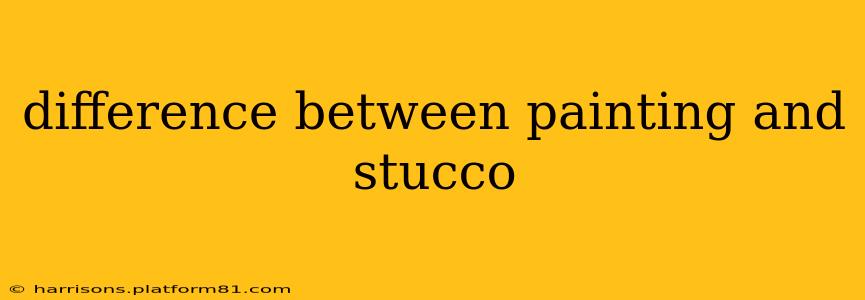Choosing between paint and stucco for your home's exterior or interior depends heavily on your aesthetic preferences, budget, and the specific needs of your project. Both offer unique advantages and disadvantages. This comprehensive guide will delve into the key differences, helping you make an informed decision.
What is Paint?
Paint is a liquid mixture that, when applied to a surface, dries to form a solid film. It’s used primarily for aesthetic purposes, offering a vast array of colors and finishes (matte, satin, gloss, etc.) to personalize any space. Paints are relatively inexpensive and easy to apply, making them a popular choice for DIY projects. However, their durability and longevity can vary significantly depending on the quality of the paint and the preparation of the surface.
What is Stucco?
Stucco is a plaster-like material applied as a protective and decorative coating to exterior walls, but also increasingly used indoors. It's a mixture of cement, sand, lime, and water, creating a durable and weather-resistant finish. Stucco offers a textured look, often with variations in color and finish achieved through different application techniques. It's known for its longevity and ability to withstand harsh weather conditions.
Key Differences Between Painting and Stucco:
Here's a breakdown of the primary differences between paint and stucco:
Material Composition & Properties
- Paint: A liquid suspension of pigments and binders in a solvent. The properties vary greatly depending on the type of paint (e.g., oil-based, water-based, acrylic).
- Stucco: A composite material of cement, sand, lime, and water. It hardens to create a solid, durable surface.
Application & Installation
- Paint: Relatively easy to apply using brushes, rollers, or sprayers. Preparation typically involves cleaning and priming the surface.
- Stucco: Requires skilled labor for proper application. The process involves preparing the base, applying layers of stucco, and finishing with textures. It's a significantly more time-consuming process than painting.
Durability & Longevity
- Paint: Less durable than stucco. It's susceptible to chipping, fading, and damage from weather exposure. The lifespan depends heavily on the quality of the paint and surface preparation; it can last anywhere from a few years to over a decade.
- Stucco: Highly durable and weather-resistant. Properly applied stucco can last for decades with minimal maintenance.
Cost & Maintenance
- Paint: Generally less expensive than stucco, both in material cost and labor. Regular repainting is required, increasing long-term costs.
- Stucco: More expensive upfront due to higher material and labor costs. Maintenance is typically minimal, mainly involving cleaning and occasional repairs.
Aesthetic Appearance
- Paint: Offers an almost limitless range of colors and finishes, providing high aesthetic flexibility.
- Stucco: Provides a textured finish, often with subtle color variations. The aesthetic is more rustic and often associated with Mediterranean or Southwestern architectural styles.
Is stucco painting necessary?
Yes, stucco does need painting. While stucco itself is durable, it’s often painted for added protection against the elements and to enhance its aesthetic appeal. The paint acts as an additional layer of protection and allows for customization of color and finish.
Can I paint over stucco?
Yes, you can paint over stucco, but proper surface preparation is crucial for a successful and long-lasting finish. This usually involves cleaning the surface, repairing any cracks or damage, and applying a primer to ensure proper adhesion.
Which is better for exterior walls?
The best choice for exterior walls depends on your priorities. Stucco offers superior durability and weather resistance, but it's more expensive. Paint is more affordable but requires more frequent maintenance.
Which is better for interior walls?
Paint is typically preferred for interior walls due to its cost-effectiveness, ease of application, and wide range of aesthetic options. Stucco is sometimes used for interior walls to create a specific textured look, but it's less common.
By carefully considering these factors, you can choose the best option—paint or stucco—to meet your specific needs and achieve your desired outcome for your project. Remember to consult with professionals for larger projects or if you are unsure about the best approach for your particular situation.
